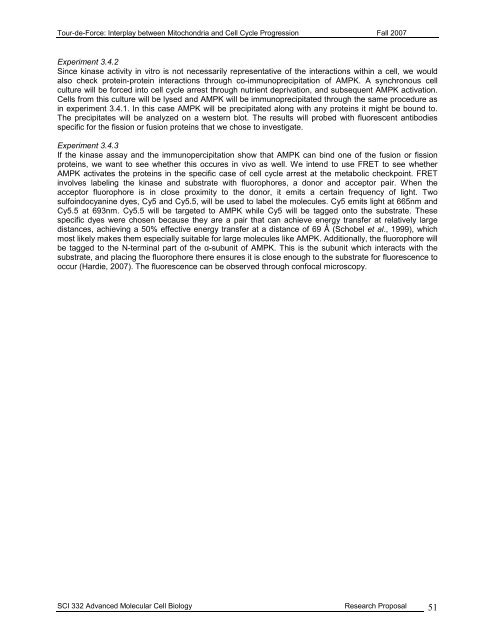Tour-de-Force
Tour-de-Force
Tour-de-Force
Create successful ePaper yourself
Turn your PDF publications into a flip-book with our unique Google optimized e-Paper software.
<strong>Tour</strong>-<strong>de</strong>-<strong>Force</strong>: Interplay between Mitochondria and Cell Cycle Progression Fall 2007Experiment 3.4.2Since kinase activity in vitro is not necessarily representative of the interactions within a cell, we wouldalso check protein-protein interactions through co-immunoprecipitation of AMPK. A synchronous cellculture will be forced into cell cycle arrest through nutrient <strong>de</strong>privation, and subsequent AMPK activation.Cells from this culture will be lysed and AMPK will be immunoprecipitated through the same procedure asin experiment 3.4.1. In this case AMPK will be precipitated along with any proteins it might be bound to.The precipitates will be analyzed on a western blot. The results will probed with fluorescent antibodiesspecific for the fission or fusion proteins that we chose to investigate.Experiment 3.4.3If the kinase assay and the immunopercipitation show that AMPK can bind one of the fusion or fissionproteins, we want to see whether this occures in vivo as well. We intend to use FRET to see whetherAMPK activates the proteins in the specific case of cell cycle arrest at the metabolic checkpoint. FRETinvolves labeling the kinase and substrate with fluorophores, a donor and acceptor pair. When theacceptor fluorophore is in close proximity to the donor, it emits a certain frequency of light. Twosulfoindocyanine dyes, Cy5 and Cy5.5, will be used to label the molecules. Cy5 emits light at 665nm andCy5.5 at 693nm. Cy5.5 will be targeted to AMPK while Cy5 will be tagged onto the substrate. Thesespecific dyes were chosen because they are a pair that can achieve energy transfer at relatively largedistances, achieving a 50% effective energy transfer at a distance of 69 Ǻ (Schobel et al., 1999), whichmost likely makes them especially suitable for large molecules like AMPK. Additionally, the fluorophore willbe tagged to the N-terminal part of the α-subunit of AMPK. This is the subunit which interacts with thesubstrate, and placing the fluorophore there ensures it is close enough to the substrate for fluorescence tooccur (Hardie, 2007). The fluorescence can be observed through confocal microscopy.SCI 332 Advanced Molecular Cell Biology Research Proposal 51
















